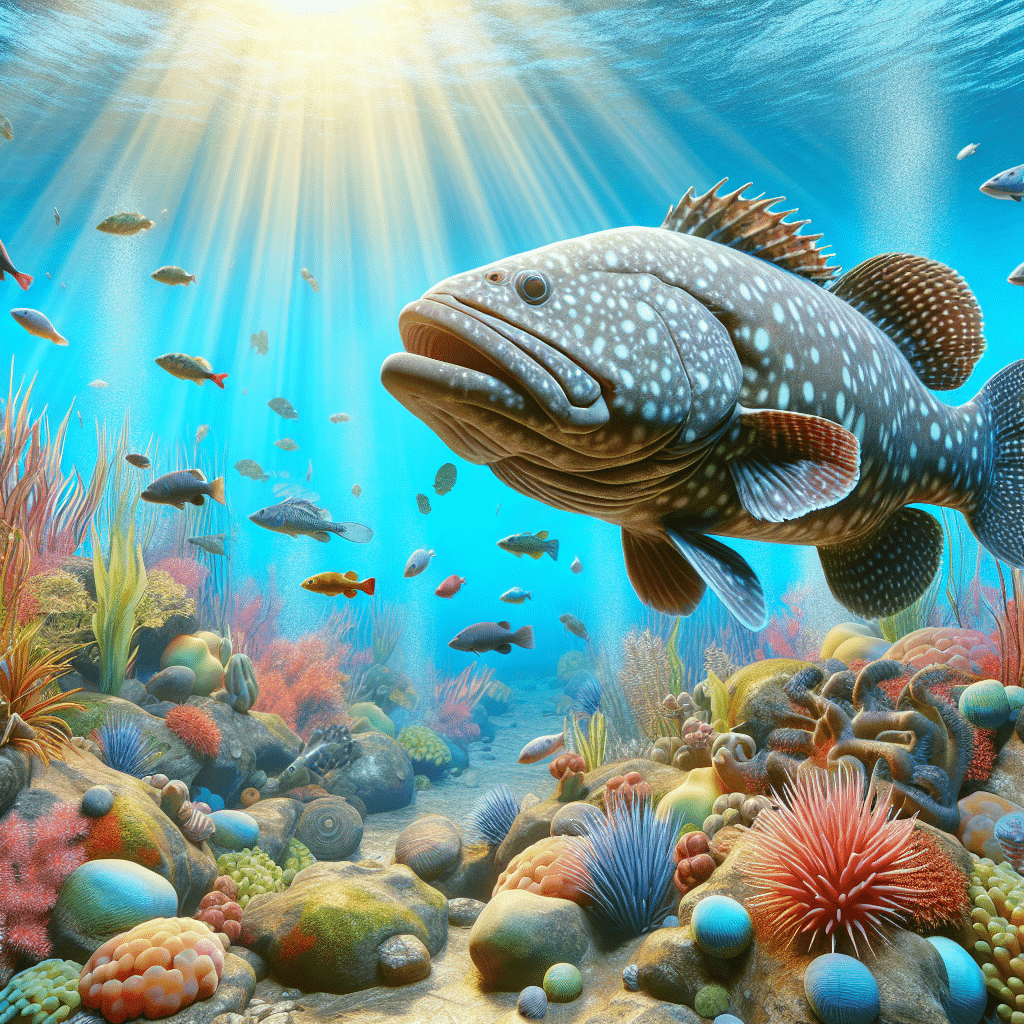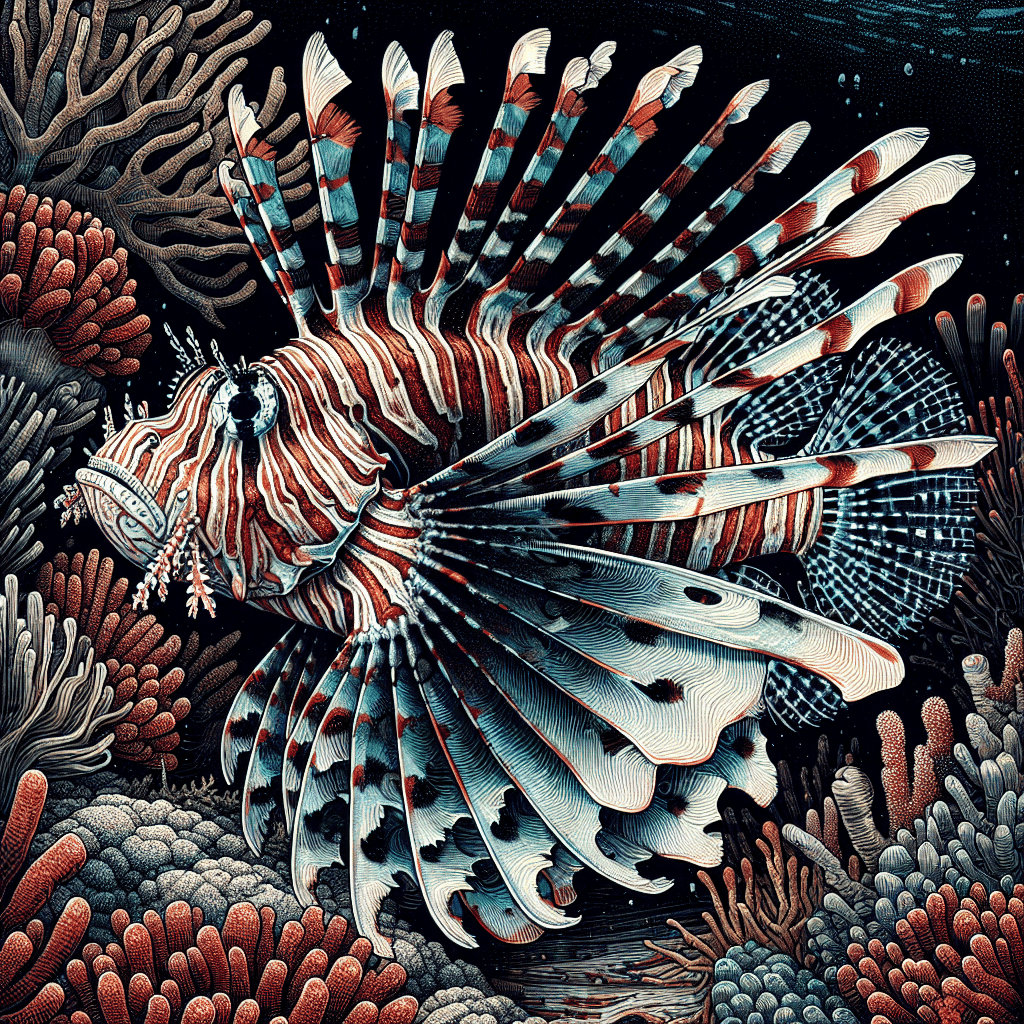The World of Groupers
When I think about groupers, I can’t help but appreciate their importance in the ocean’s ecosystem. However, they face numerous threats that can impact their populations, making it essential to understand both the challenges they encounter and their roles in marine life.
Threats to Grouper Population
Groupers are currently threatened worldwide. Overfishing has significantly impacted their numbers, as both recreational and commercial fishers target them for their meat. According to the WWF, many groupers and snappers are caught as juveniles, which means they miss out on decades of reproductive opportunities. This practice is concerning, especially since groupers are slow-growing fish.
Additionally, climate change poses a serious risk to groupers. Rising sea temperatures and changes in the ecosystem can disrupt their food supply and reproductive cycles, as spawning locations may be altered. Urban development along coastlines also leads to habitat loss, particularly affecting critical areas like seagrass beds and mangrove forests, which are vital for younger groupers and snappers (WWF).
| Threats to Grouper Population | Description |
|---|---|
| Overfishing | Targeted by commercial and recreational fishers; caught as juveniles. |
| Climate Change | Affects food supply and reproductive cycles due to temperature rise. |
| Habitat Loss | Development along coastlines destroys vital ecosystems. |
Importance of Groupers in Ecosystems
Groupers play a crucial role in maintaining healthy coral reef ecosystems. As predators, they help keep the population of smaller fish in check, which is essential for the balance of marine life. Without groupers, there could be an overabundance of certain species, leading to a decline in coral health and biodiversity. The WWF highlights that groupers contribute significantly to the well-being of the Marine Ecosystem.
Their presence indicates a healthy reef environment, and their predatory behavior assists in regulating fish populations, ultimately supporting the reef’s overall health and resilience. For hobbyists like me who keep reef tanks, understanding the role of groupers can help us appreciate their value beyond just their appearance and behavior.
Understanding the threats to groupers and their role in the ecosystem can encourage responsible practices among fish tank and reef tank hobbyists. Whether you’re considering adding a grouper to your tank or simply want to learn more about these fascinating fish, it’s essential to be informed about their environmental significance and the challenges they face.
Nutritional Value of Grouper
When I dive into the world of grouper, one of the first things that stands out is its nutritional value. This fish not only tastes great but also packs a punch when it comes to health benefits. Let’s take a closer look at its caloric content and the minerals it provides, as well as its omega-3 fatty acids.
Caloric Content
Grouper is a low-calorie fish, making it a fantastic option for anyone watching their calorie intake. In fact, it contains about 100 calories per 100 grams serving, which is quite reasonable compared to other seafood options. This makes it easy to incorporate into a balanced diet without worrying about excessive calories.
| Nutritional Aspect | Per 100 grams |
|---|---|
| Calories | 100 |
Minerals and Omega-3 Fatty Acids
Grouper is not only low in calories but also a good source of essential minerals. It contains potassium, magnesium, and selenium, which are crucial for various bodily functions such as maintaining healthy blood pressure levels, supporting bone health, and ensuring proper muscle and thyroid functions.
| Mineral | Function |
|---|---|
| Potassium | Regulates blood pressure |
| Magnesium | Supports bone health and muscle function |
| Selenium | Important for thyroid function |
Moreover, grouper is rich in omega-3 fatty acids, particularly DHA (docosahexaenoic acid). These fatty acids are essential for brain development and function. Regularly consuming grouper can improve cognitive abilities and help prevent age-related cognitive decline (Facts.net).
| Omega-3 Fatty Acids | Benefits |
|---|---|
| DHA | Essential for brain health |
Incorporating grouper into my diet is not just about enjoying a delicious meal, but also about reaping the health benefits that come with its nutritional profile. If you’re looking for more information on marine fish options, check out our section on marine fish.
Grouper Fishing
Grouper fishing is an exciting and rewarding pursuit for many anglers, whether they are seasoned pros or just starting out. These impressive fish can grow to remarkable sizes and are a popular target in various fishing spots. Here, I’ll break down some popular species of grouper and the techniques and gear I use for a successful catch.
Popular Grouper Species
There are several species of grouper that anglers commonly pursue. Here are a few of the most popular ones:
| Species | Maximum Size | Habitat |
|---|---|---|
| Red Grouper | Up to 50 pounds | Deep waters of the Gulf |
| Black Grouper | Over 100 pounds | Reefs and rocky structures |
| Goliath Grouper | Up to 800 pounds | Coastal waters, near reefs |
| Scamp Grouper | Up to 20 pounds | Rocky bottoms and reefs |
Grouper are typically found in deeper waters, but during the summer months, they can also be caught in shallower areas (In The Spread). This makes them a versatile target depending on the fishing season.
Techniques and Gear for Grouper Fishing
When it comes to catching grouper, having the right techniques and gear is key. Here’s what I usually recommend:
- Fishing Techniques
- Bottom Fishing: This is one of the most effective methods for grouper. It involves dropping bait directly to the sea floor where these fish are often found.
- Trolling: This method can also be effective, especially for larger species like the Goliath grouper.
- Using Jigs or Artificial Lures: These can attract grouper and can be quite successful.
- Gear Recommendations
- Rod: Choose a heavy and sturdy rod with medium to heavy action to handle the weight and strength of the fish.
- Reel: A conventional reel with good line capacity and a high gear ratio is essential for reeling in larger grouper.
- Bait: Effective baits include dead baitfish, live baitfish, cut bait, jigs, and soft plastics.
- Hook and Line Size: Proper hook size and line strength are crucial. Use heavier lines to withstand the powerful fighting ability of grouper.
Here’s a quick reference table for gear specifications:
| Gear Type | Recommended Features |
|---|---|
| Rod | Heavy action, sturdy construction |
| Reel | Conventional, high gear ratio |
| Line | Heavy-duty with good capacity |
| Hook Size | Varies by bait and fishing method |
Grouper fishing is not only a thrilling experience but also a way to connect with nature. In Florida, regulations set by the Florida Fish and Wildlife Conservation Commission help maintain a healthy grouper population and ecosystem. The best time for grouper fishing in this region is typically between December and April, with a daily bag limit of two fish per person.
If you’re interested in learning more about marine life, check out our sections on marine fish or explore various reef tank fish like clownfish and tang. Happy fishing!
Conservation Efforts for Groupers
Overfishing Concerns
I’ve learned that groupers, along with snappers, face serious threats due to overfishing. Both recreational and commercial fishers target these species, which has led to significant depletion of their populations. Many groupers end up as bycatch from gill-nets, long-lines, and bottom trawls. The unfortunate reality is that groupers are slow-growing fish, and most are caught as juveniles, which means they miss out on decades of reproductive activity (WWF).
In addition to overfishing, climate change poses another challenge. Rising sea temperatures and shifts in ecosystem balances disrupt the food supply for finfish like groupers and affect their survival in shallower waters. Most concerning is how these changes impact spawning grounds, which are typically consistent year after year. This disruption can lead to significant issues in their reproductive cycles.
Collaborative Conservation Initiatives
To combat these issues, various conservation efforts are underway. Organizations like WWF are working closely with fishers and other stakeholders to develop fisheries management plans and conservation tools. They focus on maintaining the effective management of marine protected areas to sustain grouper and snapper populations, as well as their critical habitats (WWF).
It’s interesting to note that at least 35 different grouper species are harvested to support small-scale, localized commercial and recreational fisheries. Since 1950, global grouper catches have skyrocketed by about 30 times, with Asian countries accounting for more than 80% of recent landings. Indonesia and China lead the way with the largest grouper landings (Fish and Conservation). These data points highlight the urgency of these collaborative initiatives and the need for sustainable practices in grouper fishing.
As a fish tank and reef tank hobbyist, understanding these conservation efforts is crucial. Not only do they impact the health of grouper populations, but they also influence the overall balance of marine ecosystems. Keeping informed about these issues can help us all contribute to the preservation of these fascinating fish and their habitats.
Unique Grouper Species
When diving into the world of groupers, I find it fascinating that there are over 234 species of these fish globally. Each species has its own unique characteristics and behaviors, making them interesting choices for aquarium hobbyists like me.
Characteristics of Different Grouper Species
Here are some notable grouper species:
| Grouper Species | Size | Weight | Habitat |
|---|---|---|---|
| Goliath Grouper | Up to 8 feet | Over 800 pounds | Coastal waters, around muddy and rocky areas |
| Nassau Grouper | Up to 3 feet | Up to 50 pounds | Rocky bottoms in clear tropical waters |
| Black Grouper | Up to 4 feet | Over 100 pounds | Atlantic waters, often found near reefs |
| Red Grouper | Up to 2 feet | Up to 20 pounds | Rocky reefs and ledges in the Caribbean |
| Gag Grouper | Up to 4 feet | Up to 50 pounds | Inshore waters, especially around reefs and wrecks |
The Goliath Grouper is particularly impressive as it’s not only the largest grouper species but also one of the largest fish in the ocean. They can grow over 800 pounds and are known for their aggressive feeding behavior, making them a favorite among anglers for the challenge they present.
The Nassau Grouper is another interesting species, often found in rocky bottoms in the Bahamas. While they may not be the largest, they are still significant in size and weight. Conservation efforts are underway to protect them, including bans on harvesting in certain areas.
Conservation Status and Behavioral Traits
Conservation status varies among species. The Goliath Grouper, for instance, was once overfished to near extinction but is now strictly protected, with recommendations for catch-and-release only (FishingBooker). Their behavioral traits are quite fascinating; young Goliaths often venture into estuaries looking for food among oyster bars.
The Black Grouper can grow to over 4 feet and 100 pounds, but the average catch in Florida is typically around half that size. These fish are known for their strength and can put up a great fight, which makes them a popular target for fishermen (FishingBooker).
Understanding the unique characteristics and conservation statuses of different grouper species helps me appreciate their role in the ecosystem and informs my choices as a hobbyist. If you’re interested in learning more about marine fish suitable for aquariums, check out our section on marine fish.
Grouper Health Benefits
Impact on Human Health
Grouper, also known as hammour fish, is not just a delicious option for dinner; it’s packed with nutritional benefits that are great for human health. This fish is rich in high-quality protein, which includes all essential amino acids, along with important vitamins and minerals. A study conducted on hyperglycemic rats showed that a diet with 25% hammour fish resulted in significantly lower levels of liver, kidney, and heart damage, as well as improvements in overall health markers like serum glucose and cholesterol levels (NCBI).
| Health Benefits | Effects |
|---|---|
| Lower Serum Glucose Levels | Yes, significant reduction with 25% fish diet |
| Decreased Total Cholesterol | Yes, gradual decrease with higher fish intake |
| Improved Organ Health | Better liver, kidney, and heart function observed |
Nutritional Value for Diabetics
For those managing diabetes, grouper fish can be a beneficial addition to the diet. Research indicates that consuming hammour fish can lead to a significant decrease in blood glucose levels. Rats fed a diet containing 25% hammour fish showed lower blood glucose levels compared to control groups, making it a promising dietary option for diabetics (NCBI).
| Parameter | Control Group | 25% Hammour Fish Diet |
|---|---|---|
| Blood Glucose Levels | Higher | Lower |
| Triglycerides | Higher | Lower |
| Total Cholesterol | Higher | Lower |
Incorporating grouper into meals not only enhances flavor but also supports better health outcomes, particularly for those looking to manage their blood sugar levels. With its rich nutritional profile, grouper is definitely a fish worth considering for a balanced and healthy diet. Explore more about other marine fish options like snapper or triggerfish for your fish tank or dinner table!
Grouper Reproductive Behavior
Hermaphroditic Nature
One fascinating aspect of grouper biology is their hermaphroditic nature. Many species of grouper are protogynous hermaphrodites, meaning they start their lives as females and can later transition into males. This unique reproductive strategy allows for a more balanced sex ratio in populations, which is particularly important for maintaining healthy breeding groups. Large males typically establish territories on coral reefs, rocky outcroppings, or even artificial reefs. In contrast, females often stay at shallower depths before migrating to these prime spawning sites during the breeding season.
Grouper exhibit a life history strategy that includes slow growth, late maturity, and long lifespans, making their reproductive behaviors even more intriguing. The ability to change sex can help ensure successful reproduction in fluctuating population dynamics.
Spawning Aggregations and Reproduction
During the spawning season, grouper gather in large aggregations at specific locations and times of the year. This synchronized spawning behavior maximizes fertilization success, which is crucial for the survival of their eggs. I’ve read that elaborate courtship displays often occur during these gatherings, typically near sunset. This timing helps reduce egg predation, giving the next generation a better chance of survival.
These spawning aggregations are not just important for the grouper; they also attract SCUBA divers and marine enthusiasts in popular tourist destinations like Palau, Belize, and French Polynesia. The chance to observe these magnificent fish during their reproductive activities adds to the allure of these locations.
For a better understanding of grouper and their unique characteristics, you might also want to explore information about other marine fish that inhabit similar ecosystems, such as the barracuda or lionfish.
Economic Impact of Grouper Fishing
Market Value of Grouper
The market value of grouper is quite staggering, with estimates ranging between $350 million and $1 billion annually worldwide. In the Gulf of Mexico, recreational fishing for grouper alone is valued at hundreds of millions of dollars, making it one of the primary targets for anglers in the region (Fish and Conservation).
Here’s a quick look at the market value breakdown:
| Region | Estimated Market Value |
|---|---|
| Worldwide | $350 million – $1 billion |
| Gulf of Mexico | Hundreds of millions |
Global Catch Trends and Fisheries
The global catch of grouper has seen a significant surge, increasing about 30 times since 1950. This boom is primarily driven by Asian countries, which account for over 80% of recent grouper landings. Indonesia and China lead the pack with the largest grouper catches, supporting both commercial and recreational fisheries.
The following table summarizes the global catch trends:
| Year | Global Catch Increase (times) | Major Contributing Countries |
|---|---|---|
| Since 1950 | 30 times | Indonesia, China |
At least 35 different grouper species are harvested to support localized fisheries, highlighting the importance of these fish not only for culinary purposes but also for economic stability in many communities. The grouper’s popularity in both commercial markets and recreational fishing illustrates its vital role in marine fisheries and the economy. If you’re interested in exploring other marine fish options, don’t forget to check out our articles on snapper, lionfish, and pufferfish.



